How They Pulled It Off: A “Garden Enclave” ADU Clad in Custom Terra-Cotta Tiles
Welcome to How They Pulled It Off, where we take a close look at one particularly challenging aspect of a home design and get the nitty-gritty details about how it became a reality.
Cars may rule the road in Los Angeles, but that wasn’t what the owners of a charming 1930s Spanish Revival–style house in L.A.’s Leimert Park wanted for their own backyard. "Like many homes of this era, the side and backyard of the home were organized with a garage at the back and a long driveway that occupied much of the 6,200-square-foot lot," says Mira Henry of local firm Current Interests. As a result, the backyard was designed more for a car than for living and gathering—not quite what the owners had in mind.
Henry and coprincipal Matthew Au sought to transform the backyard into a "garden enclave" with a new, 400-square-foot ADU at the back corner that would serve as an office and guesthouse. This move also enabled enough space to build a pool and large patio, perfect for hosting.
The grooves on the tiles result in deep shadow lines with a sense of depth and texture. Because of their longer length than the typical tile, they also have some variation in form. "When the tiles were all mounted the crafted effect of the tiles gave the facade a relaxed presence that we really love and initially could not have predicted," says Au.
Early on in the design phases of the project, the team began exploring the use of terra-cotta tiles for the building’s exterior, with the intent to create a design and material that would speak to the undulating clay tiles of the main house’s roofscape. Given Current Interest’s past experience and knowledge in material fabrication, especially ceramics, they began working with Ohio-based Sandkuhl Clayworks, a fourth-generation family-owned business that produces various ceramic and structural clay products for construction and industrial applications.
The process of creating the tiles and developing a method for installing them was a collaborative one that required an understanding of their manufacturing process.
How they pulled it off: Custom terra-cotta tiles
- Many of the products that Sandkuhl produces are hollow, with "chambers," or voids, inside that keep the block light, materially efficient, and easy to produce by an extruder. The extruder works, as Henry describes it, "like a big Play-Doh extruder" that uses an extrusion die to define the profile of the piece. Wet clay is pushed through the extruder and cut into sections, typically about 12 inches—but in this case, longer, to 20 inches in length.
Once the hollow blocks came out of the extruder, they were cut in half (while still wet) using a wire cutter to create what Henry describes as "a clay unit with dramatic vertical ribs on one side and a flat face on the other." After the tiles were air dried and fired, they were palleted and shipped to Current Interest’s studio workspace, where they were coated with a deep-green masonry pigment.
Like the tiles themselves, their installation method is unconventional. Rather than grouting them like a traditional masonry wall, they instead serve as a rain screen, where the tiles sit on a two-layered aluminum frame with vertical and horizontal members. The top and bottom courses of the frame are slightly angled, so that the tiles can overlap one another. The frame was factory painted a deep gray-green that matches the clay tiles, allowing the frame to blend in.
The interior finishes of the ADU resonate with the exterior, continuing the references to landscape and greenery. "The floor is made of green-tinted concrete with large stone aggregate layered into the top two inches of the surface," says Au. "The effect of the floor is much like a concrete terrazzo." The same exposed concrete forms the curb (the raised concrete bed around the perimeter of the new concrete slab that keeps water out), acting both as a base for the exterior wall studs and also a floor base for the interior.
The rest of the interior finishes were designed to complement the green palette of the exterior and the silvery-green notes of the floor. A green-tinted oil was applied to walnut cabinetry to create a quiet green with purple undertones, and the bathroom was clad in a silvery-purple tile. The kitchen’s natural stone countertops are neutral in tone. The result is a small but mighty ADU that is subtle and grounded in its place, and yet still makes a statement—inside and out.
Project Credits:
Architect: Current Interests / @current_____interests
Structural Engineer: Kwesi Asamoah
Published
Topics
How They Pulled It OffGet the Dwell Newsletter
Be the first to see our latest home tours, design news, and more.







